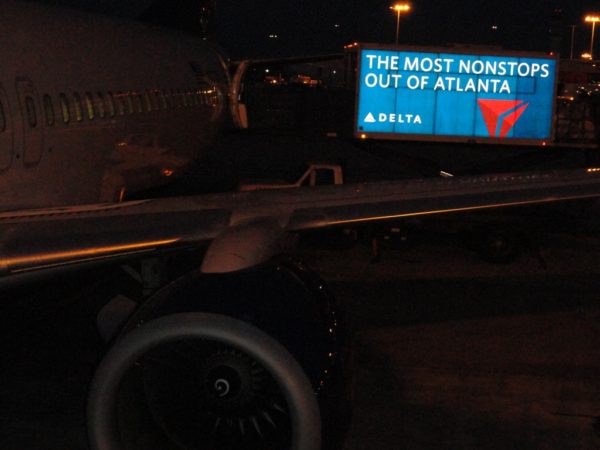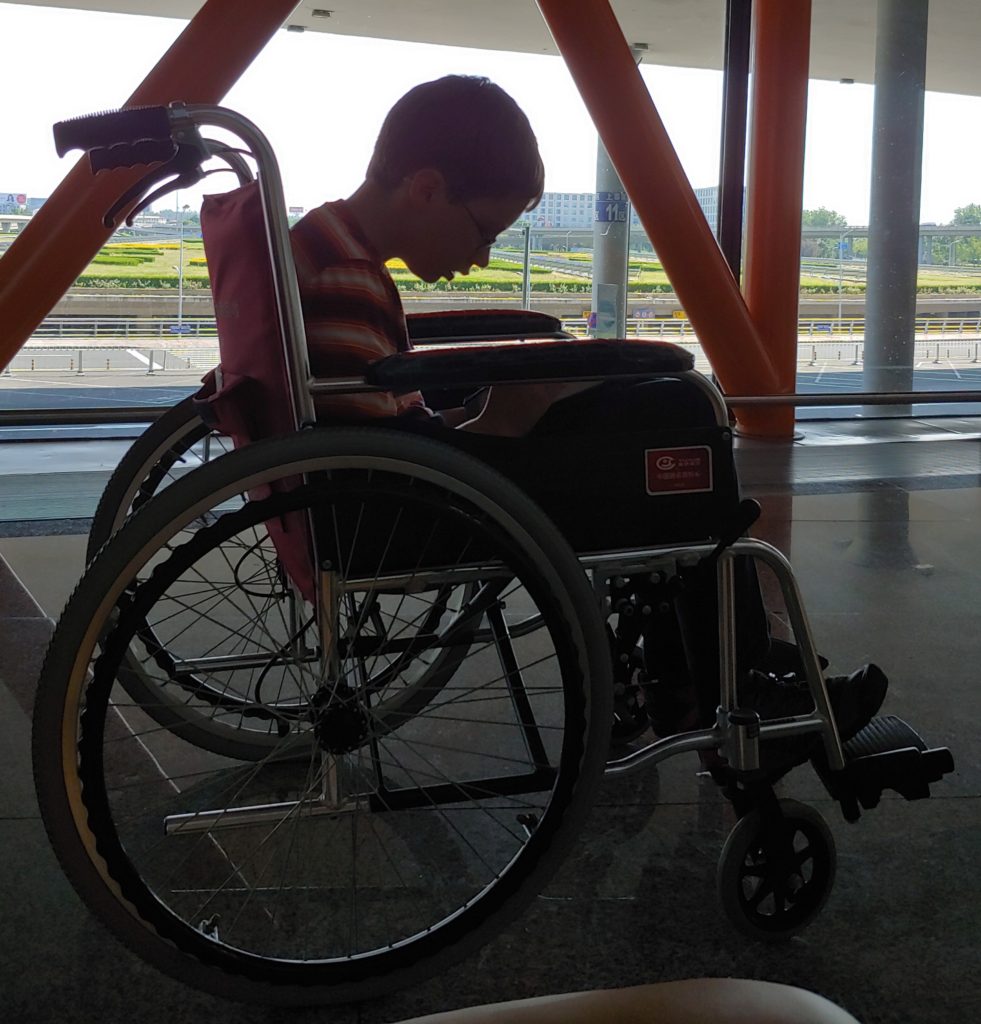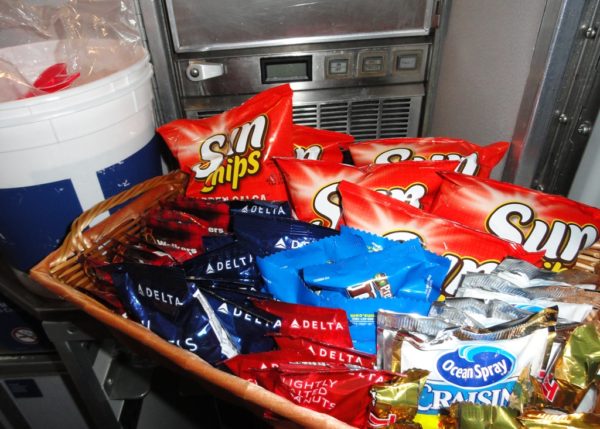The key to adventuring and flying with a special needs kid is planning and organization. I say this tongue and cheek because no matter how detailed I get and over-informed I make myself, the potholes and boulders along the beaten path are to be expected. Sometimes when the perfect plan is foiled, unimaginable possibilities open-up and the intended course takes a new direction. I embrace unexpected change – Andrew, however, does not.
Let’s face it. Traveling is stressful for anyone. It is especially stressful for passengers who have intellectual or developmental disabilities. Carefully planning every detail and starting preparations well in advance can eliminate surprises and reduce stress factors when flying with a special needs companion. As soon as I know that a flight is eminent, I start prepping Andrew. Just because he has flown before does not mean that he remembers all the details.

Non-stop Flights vs Direct Flights
I probably don’t need to say that flying non-stop is the best situation for many special needs passengers. Non-stop means exactly what it sounds like. You fly from point A to point B with no stops in between. Many passengers mix up the terms “non-stop” vs “direct” when they book flights. Direct means that the flight number remains the same but there are stops en route to the final destination. I have had many passengers shocked (and yes, irate) that they have to stop at a city or two before they actually get to where they are going.
Airline Industry Codes
All airlines love and live by acronyms. Here is a few that you will want to remember. When booking flights, you can request a Special Service Request (SSR) code called DPNA. The DPNA code stands for “Disabled Passenger with Intellectual or Developmental Disability Needing Assistance“. The code communicates to the airline that the passenger will require assistance or special preferences during their travels. On-line reservations should have a box where you can check the DPNA code box. It could be listed as SSR, or as stated above, Special Service Request. This is where making a reservation can become confusing. Every airline is different and DPNA is a code that is not often used in the United States but it should be and we are trying to change that.
Unfortunately, there is no set booking standard to add a DPNA code to a reservation. One airline will tell you to personally call them while another will have on-line instructions to communicate your needs. If you book through Expedia or other on-line booking systems you will have to personally call the airline.
My suggestion: book the flight and if you can, create the SSR, or Special Service Request, add DPNA to your itinerary and then, pick up the phone and call the airline, just to double check. Don’t assume anything! The day before departure, call and make sure that all is in order. It is worth the extra time and effort to ensure a smooth trip.

Communicating Preferences
Now the hard part. Many travelers are not aware of what kind of help is available to make their trip successful. Speak to reservations and tell them the quirks or habits of the person traveling with a disability. They might be able to make suggestions that you might not have considered. Beware though, the airlines, like all industries, have new or inexperienced employees. If you feel the suggestions are inadequate, (if you haven’t already) make a list of what would make the perfect trip and then ask if the airline can accommodate you. Requests must be within reason, after all, it is an airplane and space, as well as time, is limited.
Some travelers find it helpful to board early so that they can prepare before the onslaught of passengers. Yet, others find that boarding early with active children is too stressful.
Many passengers prefer the bulkhead seat – which is a seat that faces a wall. At the bulkhead though, all luggage must be stowed in the overhead bins for takeoff and landings. Some of us like to be able to retrieve books just after take-off. You can’t do that at a bulkhead. However, with that said, if you have a special needs person that might keep kicking the seat in front of them, then the bulk head might be the best option.
Non-ambulatory or other mobility challenged passengers have an easier time if they can get a row where the armrest moves upwards. It creates an area for them to easily slide to their seat. There are many facets that can make air travel more comfortable. You can also email us or ask for suggestions in the comment sections below.

Check the Weather Enroute
The day before departure, I’ll look at the national weather forecast to check out what types of weather systems lie between the starting airport and our destination. When most people think about weather they consider delays and cancellations. Being prepared for both is a good idea but preparing for in-flight weather needs some attention also. A line of storms between two airports can cause some disruption to service and mobility. I like to prepare Andrew ahead of time. By knowing what the in-flight weather might be, I can also guess when we will to make a trip to the restroom. There’s nothing worse than being stuck in your seat with a kid who has to go!
During a previous flight our aircraft was in a landing pattern and there was a 40 mile-per-hour crosswind. Needless to say our small plane was rocking and rolling. I glanced up at Andrew, five rows ahead of me. He had both hands in the air and was absolutely enjoying the ride. Most passengers were taking photos of him having a good time and laughing. I was mortified but then realized he was inadvertently distracting passengers from being afraid. He was just a kid having fun.

TSA Disability Notification Cards
TSA Disability Notifications cards can be handed to the agents when traversing security. The card informs the agent that the passenger they are working with might need some extra courtesies. I keep several laminated TSA Disability Notification Cards on-hand. While I do list Prader-Willi syndrome in the blank, I also add Autism Spectrum. Why? Because 90 percent of the people I come across have never heard of Prader-Willi syndrome but everyone knows what Autism is. Since Prader-Willi has many Autistic traits, it is easier to link the two together.
You can print a TSA Disability Card here.
TSA Cares Helpline
TSA Cares is a helpline that can offer additional assistance to travelers with disabilities and medical conditions. You have to call 72 hours prior to travel. They will answer questions about screening policies, procedures and what to expect at the checkpoint. TSA Cares Helpline is 855.787.2227.
TSA Passenger Support Specialist
Traveling passengers can also request a TSA Passenger Support Specialist to help them maneuver security. This might be needed for a variety of reasons like first time flyers traveling alone, persons with disabilities who need assistance traversing security or even moms traveling with a herd of small children. If it offers a piece of mind, then the PSS, Passenger Support Specialist, can help.
TSA, Random Screenings
During Andrew’s very first trip through security, he was randomly chosen to be individually screened. I had prepared Andrew for screening but had not considered him being singled out. The problem started when he was separated from his backpack because it held his snack for the gatehouse. The agent wanted Andrew to turn around. Andrew didn’t want to take his eyes off his bag and turning, meant the bag would disappear from his line of sight. What is common for many of us can cause a disturbance for our passengers that have a more rigid thought process. Because Andrew was focused on his bag, he wasn’t hearing a lot of the commands from the agent. The agent was great; Andrew left security frustrated.
TSA, Item Confiscation
The confiscation of items from passengers can heighten the anxiety and stress of children and those traveling with special needs. I have found it necessary to remind Andrew, not only about the impending pat down, but about the fact that security ‘might’ take something away. He knows that if something is removed, he has my promise that as soon as we can “we will replace it.”
I always pack emergency peanut butter sandwiches amidst our snacks and it is Andrew’s biggest fear that the agent will take our sandwiches. Actually, it is mine too. To date, our sandwiches have been routinely examined but they have not been taken away. A jar of peanut butter is not allowed in carry-on bags and sandwiches should be okay – unless you are in Cancun and the sandwich is four days old and no longer resembles peanut butter. Then, for whatever reason, they will get attention.

Sensory Overload
The early morning gatehouse can be rather calm but as the day progresses so does traveler’s stress syndrome. For some passengers, the stimulation from noise, lights, and people traffic can cause mounting stress. There is a growing number of airports that have multi-sensory rooms where special needs travelers can calm their frayed nerves. Ask the information desk or agent at check-in if sensory rooms are available.
Noise cancelling headsets are helpful and well worth the money spent. These are great, not only for noise, but can also be used with electronics. I am amazed at how many parents think that it is okay for their kids to play gadgets that can’t be quieted. I was on a bus in New York City and a toddler listened to a bouncy, little ditty for the duration of the bus ride. Child was very happy with their music and well behaved. The problem was that the tune continued throughout my sleepless night and well into the next day. You can find our favorite headset choices under travel products.
Wheelchair and Strollers
The acronym for wheelchair is “WCHR”. You can add this to your itinerary if you need a wheelchair to traverse the airport. An attendant will push the chair and assist the passenger through security and out to the gatehouse. If you plan on ordering a wheelchair at all points, ask the flight attendant before landing to make sure that you are on the assistance list. Chairs typically do not arrive at the airplane door until passengers have deplaned. It is tough to sit while other passengers grab their items and make a dash out the door. Sometimes, during peak travel hours it might take a bit for the chair to arrive. Have patience, it will.

The airlines have aisle chairs for passengers who can not walk to their seats. The wheelchair attendant will assist the passenger into the aisle chair and will make sure that seat belts are buckled before transferring to the aircraft.
The airlines also have on-board wheelchairs that can be used during flight. It can take a few moments to set the chair up and clear the aisle. This chair fits nicely through the aisle but does not fit into most domestic lavatories. A few large bodied aircraft will have wheelchair accessible lavs.
Personal wheelchairs and strollers can be checked at the door of the aircraft. These items will be walked down to the cargo hold by ramp personnel. Upon arrival at the destination city, these items will be brought back to the aircraft door. Stay seated until your crew tells you that your wheelchair has arrived. It will prevent standing in an uneven jet way or blocking the deplaning aisle.
Communicating with the Flight Crew
The crew should have a pre-departure report that lists the code DPNA or SSR by your name, provided you took the time to add it to your itinerary. Being listed with a special services code alerts the flight crew that you might need assistance or extra courtesies.
I present a postcard to the flight attendant who is greeting at the boarding door. It explains Prader-Willi syndrome and a few issues that might happen in the aircraft. It alerts the crew to Andrew’s name, age, and what seat he is sitting in, as well as my own seat. This gives me extra eyes during the flight and especially alerts the crew of Andrew’s interest in food and the dangers it can cause. If I fall asleep on a long haul, (like that would ever happen) I feel a bit more secure knowing that the crew understands the eminent danger that the snack cart is in when Andrew has convenient access.

In Air
I make it a point to remind Andrew about ‘why’ it is necessary to keep his seat belt buckled in-air – even when it is smooth. Unexpected rough air at 35,000 feet can happen at anytime and it is not predictable. So stay safe and stay buckled! For the most part, Andrew is so busy with the activity items he packed that staying in seat belted is not difficult. Check out our post: Travel Activities for Kids on the Go.
Preparing our special loved ones for travel and removing as much stress as possible is a win for everyone. Expecting the unexpected is key even after we feel we have done all the leg work.
- Plan ahead
- Communicate needs to the airline
- Read stories about flying
- Go on a field trip to the airport
- Prepare for delays and sensory overload
- Pack activities
- Plan snacks
When you’ve done everything you can, relax and always remain in control of your own emotions even under duress.
Traveling with Medications? We have you covered! You can read more about this topic at: Tips for Traveling with Medications.
*Comment Reminder* This is a safe site for children. If not tastefully stated, your comment will disappear in a “POOF”!


